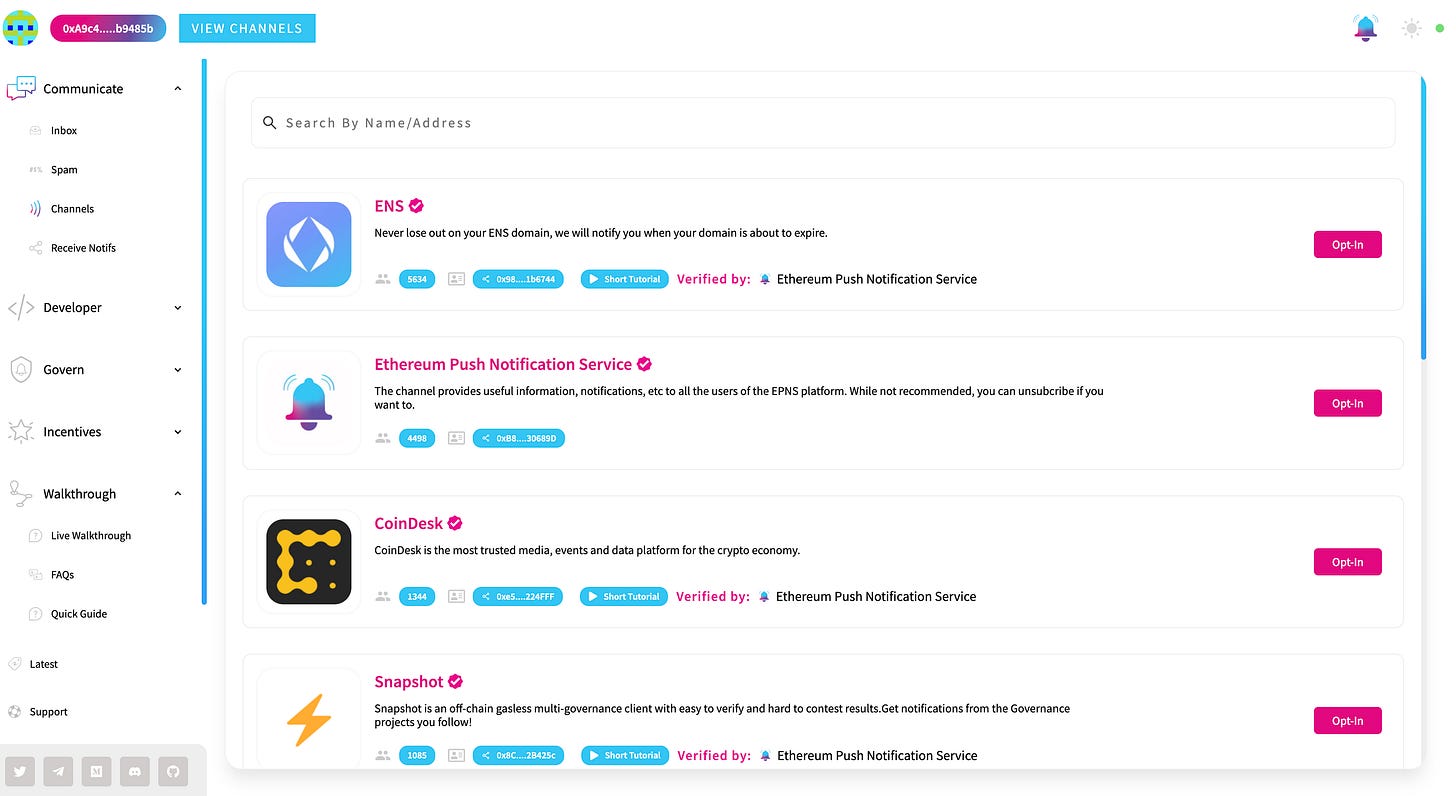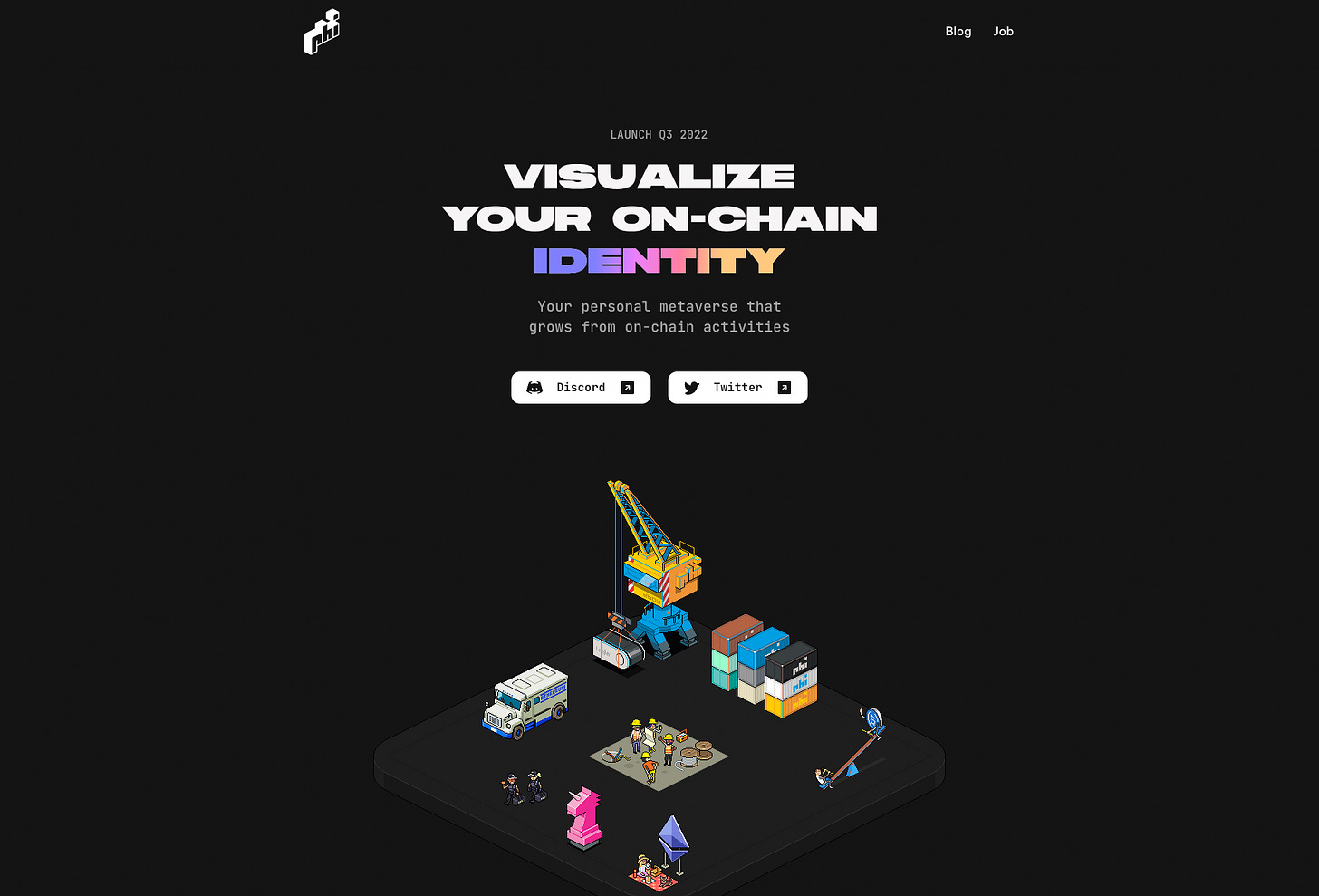Today, I’m going to start with a new series. ‘The Oracle Report’ will include a brief summary of on-chain activities happening on Ethereum. The goal of this series is to create easy to understand info of important topics in crypto that might flew under your radar. Enjoy :)
So like most of you, I was lurking crypto twitter to stay up to date in this bearmarket. I came across a very interesting tweet that mentioned several web3 apps in a picture. As an Ethereum person myself, some of these apps were unknown to me. This is why I’ve decided to dive into a couple of apps to inform you what each of these apps does. There a lot of them but I’ve decided to cherrypick the ones I think are worth it to check it out. You never know, maybe one day the effort of testing these apps will reward you with an airdrop r-r-right…?
Alright, let’s get into it.
1. EPNS
The first Dapp that caught my eye was Ethereum Push Notification Service (Coingecko: EPNS). This web3 application focuses on bringing on-chain push notifications to you.
With the recent surge in ENS hype, people are constantly minting freshly new domain names. You might have already seen the surge of 3 digit number ENS or simply being creative to find highly demanded domains (Names of big companies or most used american names). The value propositions of these ENS names could be really high based on the demand and the craziness of one person/company to buy this particular ENS. For the people owning these rare ENS domain names, I highly suggest using this Dapp. The issue is, is that you can have an ENS but you registered it for an ‘X’ amount of time. You have to renew it after this period, otherwise it expires and somebody else will snipe register it because you forgot. Would be a shame right?
I see ENS as the biggest reason why you would use this app. Im not really keen on the Coindesk notification as traditional systems like email can still be used. But I definitely see the purpose of putting notifications on ENS or Snapshot. You can opt-in with your wallet and even download browser extensions to enhance the notification process. It also seems that they have a token. I’m not really sure what the purpose is (found nothing about tokenomics in the gitbook) but it seems like it’s made for governance voting. You can Yield Farm as well to LP it and receive PUSH.
Conclusion: I don’t see much purpose of the token utility. Nonetheless, I really like this idea and tool as it can be enhanced towards even more complex notifications like oracles prices + liquidation ratio on a lending market for example. Would like to see that in the future as well.
I will use it.
2. Bungee
If you are not new to DeFi, and you use atleast a 5 fig position, I’m assuming that you are using an AMM (Automated Market Maker like Uniswap)-aggregator for shitcoins not on available on a CEX. The truth is, is that most of the time using an aggregator to do a trade is way more efficient than using a single AMM. An aggregator is simply choosing the best path to get your trade (whether its Uniswap, Sushi, Bancor etc.). One of the most well known AMM aggregator is 1inch. If you are familiar with 1inch, you will know that they charge an additional fee on top of the gas fee when doing a swap.
Bungee represents itself as a Seamless Cross-Chain Bridging. Its basically a feeless 1inch that instead of aggregating on other AMM’s, it’s doing it with bridges. A bridge to another multichain is complex and you need to find the best and convenient bridge to bridge your assets. Bungee is doing that for you for ‘free’, the only thing you need to pay is the gas fee.
I really love how it shows you in a perfect way an overview of the best way to bridge. As Bungee is feeless itself, you can directly bridge om their UI. Right now it’s in a beta phase. Might be worth it to try to bridge in case of airdrop potential. It’s a very simple UI that is easy to understand and execute.
Conclusion: Love it. I always get confused with the best paths to use for bridging but this is a very good overview. Obviously it’s in beta-phase so technically its still tricky to use. Nonetheless, its a web3 tool that definitely should be in your pocket sleeve.
3. POAP
POAP (Proof of Attendance Protocol) is a way of keeping a reliable record of life experiences and events. Each time they take part on an event, POAP collectors get a unique badge that is supported by a cryptographic record. These badges are Non Fungible Tokens (NFT) and open a whole new world of possibilities. Ive known the founder @worthalter for roughly 3 years now and I know he is deeply embedded within the Ethereum community. POAP is one of the most well known web3 apps because of the unique approach of looking at NFTs.
I like to compare it with in games achievement. You unlock badges based on witnessing events or own personal achievements. Because of the cryptographic background, you can really prove that you have been there. I was actually hoping that everybody would get a ‘2022 downhill rollercoaster’ POAP after the downfall of LUNA, 3AC, CeFi companies and many more. Atleast we could share the tears with our grandkids, right?
You can do much more with it, like creating raffles for the people that own a POAP of a certain event. I see a big future in this, for example companies/foundations that are doing a giveaway for SaaS subscribers for example.
Conclusion: the whole marketing game is going to be changed by POAP because it simply generates more community engagement when you are part of something ‘rare’. Being given an ‘exclusive’ title in the form of a POAP that everybody can see, would likely engage more than letting everybody participate. It’s simply human psychology.
4. PHI
This one is interesting. PHI is trying to create your Web3 World that evolves with your On-Chain activities. I would like to point out that they have not launched yet, but they will likely do so in q3 of 2022.
From reading their medium article, it seems like that they want to generate a virtual land for everybody that owns an ENS. Obviously, the metaverse is the next big thing. Problem is, is that you have to be early to acquire some land in a cheap way. PHI is letting you generate this piece of land if you own an ENS. But you might ask yourself: what makes it valuable if everybody gets a piece of land. Outside of the ‘Phi Land’ component, there is a second component in the game: ‘Phi Object’. These are objects that are generated on your land that represents on-chain activities (achievements, status, communities etc.).
How PHI differentiates itself from being a random land generator:
PHI land: Lands generated from ENS domains. ENS can work as a Metaverse address system(e.g. vitalik.eth would be Vitalik’s Metaverse land address.)
Phi Object: Objects(ERC1155) tied to various on-chain activities.
Examples of on-chain activities to claim Phi Objects:
Token Holding: Holding more than 1 ETH
Token Swapping: Swapped 1/5/10 times on Uniswap
NFT Holding: Holding 1 Loot
Voting: Voted more than 1 time on Snapshot.
Conclusion: I really love this idea and approach. It’s really smart from them to focus on doing a potential ENS airdrop of pieces of land. ENS is by far the number 1 web3 identity app and by giving a piece of land, the engagement rate goes skyhigh (who doesnt want to explore something that has been given for free right?). It invites people to engage and farm web3 activities to unlock a unique metaverse identity.
These were the most promising apps that got my attention. The rest of the apps were too much focused on social media type of web3 apps (not my favourite niche) or I simply couldn’t find the website. Or I simply didn’t care enough about the purpose of the project.
Let me know in the comments about your opinion.
Zoomeroracle.
URLs
Twitter: @ZoomerOracle
GMX referral link: http://gmx.io/#/?ref=zoomeroracle
ETH Address: Zoomeroracle.eth











Just recently found out about Bungee myself and I blown away by how easy and seamless it is relative to its competitors yet we barely hear about bungee